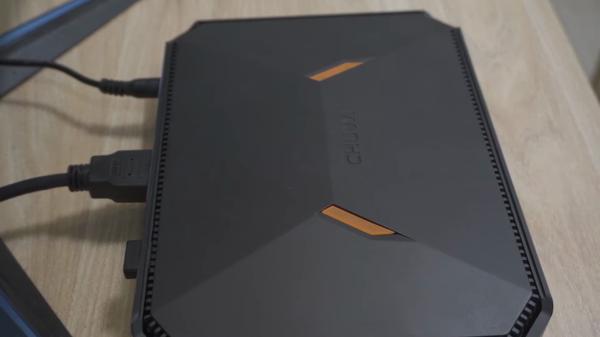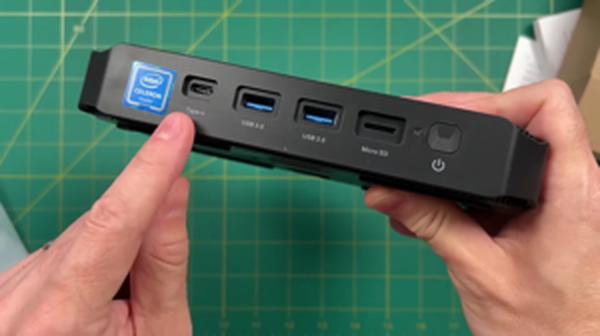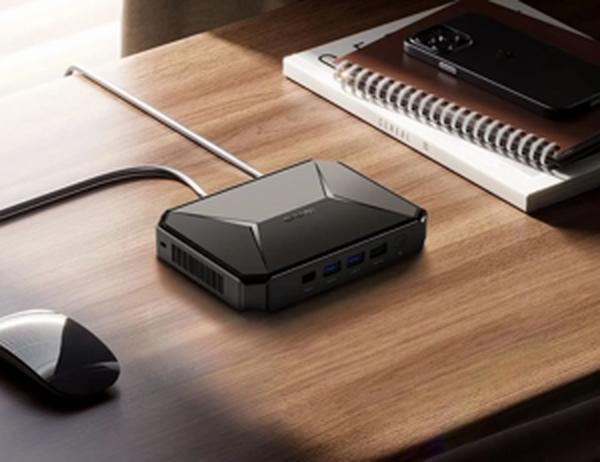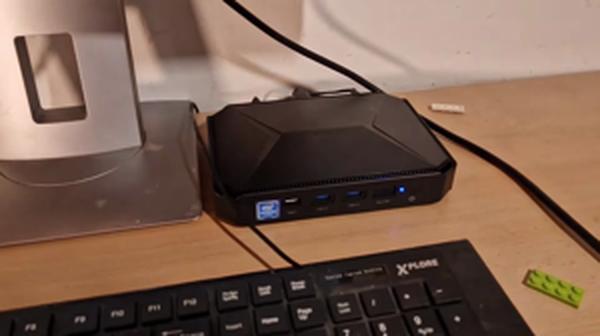Trying out a Mini PC: CHUWI 2023 Herobox Intel 12th Gen N100
Introduction
I recently got my hands on the CHUWI 2023 Herobox, a mini PC that's been generating quite some discussions / comments online. I quite like compact and efficient computing solutions, and have seen this deviced as being suitable for minimalists and those looking for a secondary workstation. With its fanless design and small footprint, it promises to deliver a quiet and space-saving experience.
Unboxing and First Impressions

Unboxing the CHUWI 2023 Herobox was an exercise in managing expectations. Having followed the discussions on Hackernews and Reddit, I approached this minimalist piece of technology with a healthy dose of skepticism mingled with curiosity. Out of the box, the Herobox's compact form factor immediately struck a chord. Its diminutive size, hardly larger than my hand, spelled convenience and unobtrusiveness, a welcome departure from the hulking towers of yesteryear.
Setting it up was smooth, with all necessary ports and connectors easily accessible. I appreciated the assortment of USB ports, including two USB 3.0, two USB 2.0, an HDMI, a VGA, and a Type-C—certainly ample for peripheral connectivity. For those interested in the perfect display setup, exploring monitor options for the Mac Studio can also provide insights into making the most out of your connections. However, the lack of a second HDMI port was a small letdown, as it limits dual-monitor setups that use that specific connection type.
Booting it up, I was greeted with Windows 10, devoid of the despised bloatware that often accompanies new PCs. The lack of unwanted apps was a breath of fresh air and highlighted CHUWI's respect for user preference and convenience—an approach seemingly aligned with the ethos of free software communities, like those on GitHub, who advocate for user control and minimalism (source).
The HeroBox's fanless design sang to me in silence. Even as I loaded up multiple tabs on Chrome and played a YouTube video, the absence of auditory distractions was a highlight. The efficiency of the device shone through here, running cool under light use and establishing the Herobox as a workhorse for basic tasks such as document editing and browsing.
Yet, the unit wasn't without its caveats. The onboard WiFi proved weaker than desirable, struggling at times to maintain a stable connection where other devices had no issue. This inconsistency might necessitate the use of an additional WiFi dongle, which, while not a deal-breaker, is an additional expense and a small blemish on an otherwise sterling feature set.
Furthermore, the device's heart, the Intel Celeron N4100 processor, while adequate for light tasks, posed questions about its performance with more demanding applications. Details like these are critical for potential users to consider, as they frame the HeroBox's capabilities in an honest light, informing consumer choice in a market flooded with options.
Notwithstanding these drawbacks, the initial experience with the CHUWI HeroBox left me cautiously optimistic. The appeal of a mini PC is clear—it caters to a distinct niche that craves minimalism, efficiency, and value. And while the HeroBox might not be the juggernaut some enthusiasts seek, it stands as a testament to how far technology has come in delivering competence in unassuming packages. The feeling of unraveling this device was akin to leafing through a well-written manual—straightforward, informative, and fundamentally useful.
Certainly, for users with moderate computing needs, or those in search of a secondary device that exemplifies 'less is more,' the CHUWI HeroBox appears to step up to the plate. As I ventured past the unboxing and initial setup, I was prepared for a deeper dive into the everyday practicality of this deceptively small desktop.
Performance and Daily Use Cases

In my continued use of the CHUWI 2023 Herobox, I've been largely impressed with its performance in day-to-day tasks, similar to how I've found the Dell Optiplex 9020 SFF Desktop suitable for small spaces. As a compact mini PC, it has seamlessly integrated into my workspace, which is especially cramped in my dorm room. Its form factor is undeniably convenient, and it's been handling most of my needs effectively — from web browsing to streaming services and handling light office work.
The fanless design deserves praise for keeping operations utterly silent, which is a significant advantage for me given that I often work late into the night with roommates sleeping nearby. I didn't notice any overheating issues, although I've stuck to tasks that are well within the unit's performance bracket.
Equipped with Windows 10, the Herobox did come with its kinks. Post-setup updates were a bit of a chore, and there's a noticeable delay as it wrestles with Windows 10's more demanding moments. However, I did manage to upgrade to Windows 11, which was a smooth transition and improved the UI experience.
Those looking for advanced settings and UEFI controls might hit a snag, as the BIOS options are somewhat limited. It wasn't a deal-breaker for me, but it's worth noting for anyone needing extensive control over their hardware settings. On GitHub, discussions around personal tweaks and optimizations for devices like the Herobox suggest a mixed bag of experiences, but I found comfort in knowing that there's an active community tinkering with similar issues.
As for gaming, don't expect this minuscule box to handle the latest AAA titles. It does settle nicely into a niche for older games and an emulator haven, proving sufficient for the casual gamer. When it comes to using this device for streaming, the Herobox manages to handle 1080p content with relative ease; I streamed my favorite shows without the slightest hiccup. However, pushing it to 4k can result in performance drops, which is not unexpected, but something potential buyers should be aware of.
For office tasks, it's mostly smooth sailing. The 8GB of RAM felt ample for juggling multiple tabs on Chrome and handling day-to-day software like Microsoft Office. It's certainly not the speediest machine I've used, but at this price point, I never found myself frustrated waiting for applications to respond.
Connectivity with peripherals was straightforward, and I appreciated the abundant USB ports. However, I did have an issue with Wi-Fi connectivity. While it's advertised to support modern standards, I observed a weaker signal than I'm used to. This Wi-Fi inconsistency is something I've worked around by using an Ethernet cable, but this may not be ideal for all users.
In summary, the CHUWI 2023 Herobox has fitted quite well into my computing lifestyle. The trade-offs are clear: it's not a powerhouse, and it won't please everyone, but for those needing a reliable, quiet, and compact system for standard computer use, it's a compelling choice. I anticipated certain limitations when I picked this little PC up, and I've adjusted my expectations accordingly. It serves my purposes and hasn't let me down yet, especially considering the affordable investment.
Connectivity and Expansion

When it comes to connectivity and expansion options, the CHUWI Herobox really shines for its size and price point. I've been pleasantly surprised by the array of ports available. It comes packed with two USB 3.0 ports, two USB 2.0 ports, a USB-C port, HDMI, VGA, and a MicroSD card slot. This variety offers me the flexibility to connect multiple devices, including my monitors, making it an excellent choice for a multi-display setup.
One of the first things I did was make use of the USB 3.0 ports to attach an external hard drive for additional storage. The data transfer rates were impressive, and it was an easy way to expand the internal storage without having to open up the device. The inclusion of a USB-C port is a modern touch that I appreciate, allowing me to hook up the latest peripherals without requiring an adapter.
The dual monitor support, courtesy of HDMI and VGA, is a key feature for my productivity setup. It allows me to extend my desktop across multiple screens, which is invaluable for my workflow. The video outputs are capable of handling day-to-day office tasks and video streaming, although they're not suited for high-end graphics-intensive tasks due to the integrated GPU limitations. The MicroSD slot is a nice addition as well, providing a quick method to transfer photos and files from my mobile devices.
On the downside, while the HeroBox does come with an Ethernet port for wired network connections, some users have reported issues with getting it to work at gigabit speeds. From my experience, it's performed reasonably well, but I've heard enough from others online to know that it could be a potential hiccup. I primarily use Wi-Fi, which has been stable and fast for my needs.
One omission that I noticed was the lack of an optical audio output, which isn't a deal-breaker but would have been appreciated for connecting to older audio receivers. However, for most users, the HDMI audio output should suffice, especially when connected to modern sound systems or monitors with built-in speakers.
In terms of internal expansion, there is room to add another SSD, which is a great way to increase the device's storage capacity. The process isn't too complicated, but for those not comfortable with opening their devices, external storage might be the easier way to go.
The CHUWI Herobox also supports Bluetooth, which is crucial for connecting wireless peripherals like keyboards and mice, significantly reducing cable clutter. Being able to pair Bluetooth speakers or headphones is a welcome feature when needing to switch to private listening.
For developers or tech enthusiasts looking to experiment, the HeroBox's compatibility with different operating systems is an added bonus. Running different flavors of Linux or setting up a home server can be done with relative ease, further demonstrating the device's versatility. For those considering a Linux-based system, my thoughts on whether Linux laptops are worth it as we enter 2024 may provide valuable insights.
In all, the CHUWI Herobox's connectivity and expansion capabilities offer a balanced mix for a mini PC. It may not have the latest Thunderbolt ports or support for 4K displays, but considering its target audience and price bracket, it's armed well enough to handle a diverse range of scenarios, from simple office use to being a compact home entertainment center.
Final Thoughts and Recommendations

After several months with the CHUWI 2023 Herobox, I've garnered a fairly balanced perspective on its capabilities and limitations.
On the one hand, it's a commendable little machine for certain tasks—ideal for light office work, streaming, and basic web browsing. The compact design and silent operation have been a major plus, fitting unobtrusively into my workspace without the hum of a fan to disturb the peace. The unreliability of the Ethernet connection was a hiccup, but switching to a different cable seemed to resolve the issue, highlighting how sometimes problems aren't where we expect them to be. That said, I didn't appreciate finding out the hard way.
Performance-wise, I'm quite impressed with its boot speed and general responsiveness. For a device at this price point, I didn't encounter significant lag during my typical usage, which speaks volumes for those who need a budget-friendly workhorse. The fact that it could be coaxed into running Linux distributions like Ubuntu and even accommodate server tasks is a nod to its versatility for the tech-savvy crowd.
There have been a few downsides, though, primarily the internal Wi-Fi's weaker signal which can be a deal-breaker for users dependent on wireless connections. Plus, while the passive cooling is a silent blessing, it's not without its thermal challenges. Pushing the Herobox with intensive tasks could see temperatures rise uncomfortably, risking longevity and performance issues. The SSD failure reported in some thoughts also looms as a potential concern, especially since storage reliability is non-negotiable for a primary device.
When it comes to gaming or heavy multimedia creation, the Herobox falls short. But that's not a drawback as much as a reality check; the hardware simply isn't designed for high-end graphics or CPU-intensive applications.
In terms of support, CHUWI's responsiveness to customer issues—like stepping up with a new replacement unit—brings some reassurance, though others' experiences suggest that this may not always be as smooth.
Anyone considering the Herobox should weigh its affordability against these performance limitations. It's not a powerhouse, nor is it the most robust piece of technology. But for users with moderate demands and a tight budget, it holds its own admirably.
As for recommendations, I would definitely underscore the need for potential buyers to consider their use case: if it aligns with what the Herobox offers, it's certainly worth the investment. Just be mindful of its limitations and perhaps keep a contingency for things like additional storage or a USB Wi-Fi dongle, which, in my opinion, are fair trade-offs at this price bracket.
Overall, the CHUWI 2023 Herobox’s journey has been a lesson in managing expectations. It does 'budget' as well as one could hope, and for those with clear-eyed views of what 'budget' can deliver, it may well prove a nifty gadget indeed. Just remember, while it can step into the shoes of a more expensive Mini PC for certain tasks, it cannot—and does not pretend to—fill those shoes all the time.
Share
I happened to be looking at this very machine, wondering if it would suit my modest needs. Your beautifully written review tipped me. As somewhat a writer myself, I'd just like you to know that I appreciate the work you out into this. Thank you.